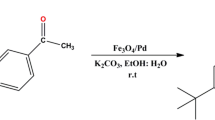Abstract
A tetrahedral skeleton is considered to belong to the RS-stereoisomeric group denoted by \({\mathbf{T}}_{d{\widetilde{\sigma }}{\widehat{I}}}\). By placing proligands on the four positions of the tetrahedral skeleton, the resulting promolecule is considered to belong to a subgroup of \({\mathbf{T}}_{d\widetilde{\sigma }\widehat{I}}\), where its RS-stereoisomeric properties are illustrated by the corresponding stereoisogram. Three aspects of an absolute configuration, i.e., a chiral aspect, an RS-stereogenic aspect, and a scleral aspect, are formulated on the basis of three attributes of a stereoisogram, i.e., chirality, RS-stereogenicity, and sclerality. The RS-stereodescriptors of the Cahn-Ingold-Prelog (CIP) system are clarified to specify the RS-stereogenic aspect, so that they are assigned to a pair of RS-diastereomers contained in a type-I, type-III, or type-V stereoisogram. To apply the RS-stereodescriptors to the chiral aspect of an absolute configuration, the concept of chirality faithfulness is redefined by proposing odd and even priority permutations.









Similar content being viewed by others
Notes
Suppose that a molecule is diastereomeric to a reference molecule. Then, another molecule enantiomeric to the former molecule is also diastereomeric to the reference molecule. This means that a set of diastereomeric molecules contains a pair of enantiomeric molecules.
References
IUPAC Organic Chemistry Division, Pure Appl. Chem. 68, 2193–2222 (1996)
IUPAC Chemical Nomenclature and Structure Representation Division, Provisional Recommendations. Nomenclature of Organic Chemistry (2004), http://www.iupac.org/reports/provisional/abstract04/favre_310305.html
G. Helmchen, in “Stereoselective Synthesis”, 4 ed., ed. by G. Helmchen, R.W. Hoffmann, J. Mulzer, E. Schaumann (Georg Thieme, Stuttgart New York, 1996) Vol. 1 of Methods of Organic Chemistry (Houben-Weyl). Workbench Edition E21 pp. 1–74
E.L. Eliel, S.H. Willen, M.P. Doyle, Basic organic stereochemistry (Wiley-Interscience, New York, 2001)
S. Fujita, J. Org. Chem. 69, 3158–3165 (2004)
S. Fujita, Tetrahedron 60, 11629–11638 (2004)
S. Fujita, J. Math. Chem. 35, 265–287 (2004)
S. Fujita, MATCH Commun. Math. Comput. Chem. 52, 3–18 (2004)
S. Fujita, J. Chem. Inf. Comput. Sci. 44, 1719–1726 (2004)
S. Fujita, MATCH Commun. Math. Comput. Chem. 53, 147–159 (2005)
S. Fujita, MATCH Commun. Math. Comput. Chem. 54, 39–52 (2005)
S. Fujita, MATCH Commun. Math. Comput. Chem. 61, 11–38 (2009)
S. Fujita, J. Comput. Aided Chem. 10, 16–29 (2009)
S. Fujita, Stereoisograms: A remedy against oversimplified dichotomy between enantiomers and diastereomers in stereochemistry, in Chemical information and computational challenge in the 21st century, Chapter 9, ed. by M.V. Putz (Nova, New York, 2012), pp. 223–242
S. Fujita, Tetrahedron 62, 691–705 (2006)
S. Fujita, Yuki Gosei Kagaku Kyokai-Shi. J. Synth. Org. Chem. Jpn. 66, 995–1004 (2008)
S. Fujita, MATCH Commun. Math. Comput. Chem. 61, 39–70 (2009)
S. Fujita, J. Comput. Aided Chem. 10, 76–95 (2009)
S. Fujita, Prochirality and Pro-RS-stereogenicity. Stereoisogram approach free from the conventional ‘Prochirality’ and ‘Prostereogenicity’, in Carbon bonding and structures. Advances in physics and chemistry, Vol. 5 of carbon materials: chemistry and physics, Chapter 10, ed. by M.V. Putz (Springer, Dordrecht, Heidelberg, London, 2011)
S. Fujita, Symmetry and combinatorial enumeration in chemistry (Springer, Berlin-Heidelberg, 1991)
S. Fujita, Diagrammatical approach to molecular symmetry and enumeration of stereoisomers. University of Kragujevac, Faculty of Science, Kragujevac (2007), Vol. 4 of Mathematical Chemistry Monographs Series
S. Fujita, Combinatorial Enumeration of Graphs, Three-Dimensional Structures, and Chemical Compounds, University of Kragujevac, Faculty of Science, Kragujevac (2013), Vol. 15 of Mathematical Chemistry Monographs Series
S. Fujita, J. Math. Chem., 52, 508–542 (2014); doi:10.1007/s10910-013-0276-y (2013)
S. Fujita, J. Math. Chem., 52, 543–574 (2014); doi:10.1007/s10910-013-0277-x (2013)
K. Mislow, Introduction to stereochemistry (Benjamin, New York, 1965)
N. North, Principles and applications of stereochemistry (Stanley Thornes, Cheltenham, 1998)
D.G. Morris, Stereochemistry (Royal Society of Chemistry, Cambridge, 2001)
S. Fujita, Tetrahedron 65, 1581–1592 (2009)
S. Fujita, MATCH Commun. Math. Comput. Chem. 61, 71–115 (2009)
R.S. Cahn, C.K. Ingold, V. Prelog, Angew. Chem. Int. Ed. Eng. 5, 385–415 (1966)
K. Mislow, J. Siegel, J. Am. Chem. Soc. 106, 3319–3328 (1984)
V. Prelog, G. Helmchen, Angew. Chem. Int. Ed. Eng. 21, 567–583 (1982)
J.H. van’t Hoff, Die Lagerung der Atome im Raume (German Translation by F. Herrmann), Friedrich Vieweg und Sohn, Braunschweig (1877)
Author information
Authors and Affiliations
Corresponding author
Rights and permissions
About this article
Cite this article
Fujita, S. Three aspects of an absolute configuration on the basis of the stereoisogram approach and revised terminology on related stereochemical concepts. J Math Chem 52, 1514–1534 (2014). https://doi.org/10.1007/s10910-014-0326-0
Received:
Accepted:
Published:
Issue Date:
DOI: https://doi.org/10.1007/s10910-014-0326-0




